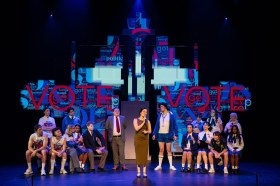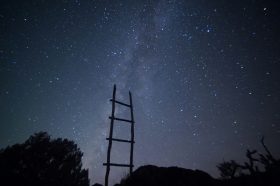As discussed in my previous ArtsHub article, the Indigenous arts sector in Gimuy/Cairns (while a thriving ecosystem in many ways) is in a state of flux, without multi-organisational approaches due to a number of contributing factors. In the more dire scenarios, simply the wrong people are engaged. But it isn’t just on them – nay, us – it’s on funding bodies that have watched this unchecked rapid growth and now “soft”, but unmeasured, damage occur.
The concerted, commercial emerging contemporary Indigenous arts movement that began in Tropical North Queensland (TNQ), in the mid-late 2000s, has now hit a wall and is in danger of stagnating beyond repair. Not just on an administrative front, but also due to an absence of academic and literary critique on the part of arts writers and curators.
For example, the artistic output from TNQ is seen more as “given filler” than as a major movement – Queensland Art Gallery of Modern Art’s collection of Queensland Indigenous art pales in comparison to that of the National Gallery of Victoria’s. Likewise, we’re used to being overlooked for major survey exhibitions (the National Gallery of Australia’s 4th National Indigenous Art Triennial remains a prime example).
With the Queensland Government’s eye cast towards the upcoming Brisbane Olympics, the sector should be worried about any financial wastage and lack of self-motivation. Creative Australia is unfurling and boasts new funding and strategic guidelines, especially to do with the Indigenous art sector in the First Nations First pillar of the National Cultural Policy. It has listened and it has acted, but there remains a lack of outline towards a nationwide authoritative body for the Indigenous arts sector (which was a widely acknowledged early goal of the 2022 Parrumpa gathering in Tarntanya/Adelaide). There’s now a wide open space to devise a restructure of the sector, and the timing is most suitable. It’s something Merindah Donnelly has voiced on ArtsHub before, too.
The future
The Queensland Government’s Regional Arts Services Network (RASN) was established post the handing down of the Creative Together 2020-2030 Roadmap. RASN’s purpose is to connect regional-based arts enterprises and activities, distributing a bucket of $7.8 million over its first four years.
This work to invest in regional arts is complemented by the Regional Arts Fund, a national program that provides around $6 million per year to artists and communities in regional and remote areas. The Fund is managed by Regional Arts Australia and organisations in each state and territory, which for Queensland is the Flying Arts Alliance.
Though, the true effectiveness of RASN in Queensland has been called into question by some industry colleagues I’ve been speaking with as background to this piece. However, RASN has room to play a strategic role in mapping out a cohesive plan for the aspirations of Indigenous communities in particular. Just, at present, they haven’t the aptitude, nor the capacity to do so (being housed within a strictly development organisation with minimal Indigenous board representation and none from Cape York or the Torres Strait: Regional Development Australia Tropical North Queensland government initiative).
As a first step (and not at all specific to the apparent housekeeping needed on an individual, organisational basis), the future of the Indigenous art sector as a whole should be frameworked from a national/Commonwealth Government level. But it can begin in Gimuy/Cairns. In fact, the options for how better to oversee and support Indigenous art organisations, namely Indigenous Art Centres, can begin by the decentralisation of the Indigenous Visual Arts Industry Support (IVAIS) fund, engaging with state counterparts to manage this fund and recipients.
The existing Indigenous arts organisations here in Gimuy (and publicly-funded enterprises) must band together in a Memorandum of Understanding (MOU) and this MOU should be workshopped under advisement of Arts Law, the Indigenous Art Code, recommended stakeholders and industry colleagues, and both state and Commonwealth governments – collectively ratified by a consensus of mutual membership. This MOU should not only map out Terms of Engagement for themselves as signatories (to do with collaborative and representational systems), but also of updated Cultural and Best Practice obligations/standards to be enacted by each as eligibility for being a signatory.
Under this MOU the signatories must be compelled – with adequate, cross-jurisdictional feasibility study funding and the study to be carried out by a third-party consultancy – to develop a model for a Queensland-wide First Nations arts statutory peak body (with scope to expand in more inclusive stakeholder priorities across art forms). This model should then be adopted across Australia with Creative Australia’s confirmed backing and continued support.
Collaboration is key
This piece has been a critical analysis, of sorts, of the chief players at the forefront of the Indigenous art sector across Tropical North Queensland, but it isn’t a critical piece per se. As all tangible studies demonstrate, we are doing fine work and are supporting more and more artists/creatives and arts professionals than ever before. Though, each player seems to be operating in silos, none more so than independent artists.
The Queensland Independent Artists Alliance was established through sheer opportunistic and emotional response to what its organisers’ perceived as a lack of consultation in the lead-up to Creative Australia’s Parrumpa gathering. The body hasn’t made any significant headway (which I’m doubtful was even its focus). Either way, what its website outlines as Calls to Action is not dissimilar to what I and others are calling for: chiefly a national authority body (with statutory empowerment) to oversee the goings-on of our creative and Cultural enterprise spaces.
Read: Cultural collaboration between remote Kimberley art centres
Independent artists as sole traders do make up the backbone of the arts industry more broadly, and where we sit in the advocacy and structural ecosystem is not yet identified (beyond rewarding membership and recognition by the National Association for the Visual Arts and the Indigenous Art Code etc).
The positioning and representation of independent Indigenous artists has not been ignored either; Umi Arts, for all intents and purposes and, despite internal problems, is well-placed to continue to pursue our showcasing interests, as a membership-based organisation. Cairns Indigenous Art Fair established the Independent Artists Program in 2020 (grown now to become its newly announced Catapult program – with added financial supports to develop opportunities for independent artists). This continues to set aside room within its Art Fair component for independent artists to be featured. This is revolutionary in many meaningful ways for artists who may struggle to source the finances to pay for booth space, who perhaps haven’t stock enough to fill an entire booth on their own, and who haven’t been hand-picked by the lucrative agents and dealership galleries.
What we’re seeing, through these examples, are isolated moves by the current sector to fill many apparent gaps – players who just need funding support, operational and strategic collaborative approaches and new vigour. And it should be acknowledged that government funding bodies are paying attention and do facilitate advancements across most of the matters discussed herein. Though, perhaps more could be done to strategise and police funding investments and conduct interventions in times of governance and human resources crises.
Undeniably, there’s much to be grateful for – for the pathways created before us (in large part thanks to the early years of TAFE programming, which saw local legends like the late and great Thancoupie, Billy Missi, Arone Meeks and their contemporaries come through). TAFE, while still offering a wide range of arts skills courses, can play a key role in lobbying for curriculum inclusions to be adopted by governments for specific “arts worker training” courses.
Furthermore, regional arts organisations such as Arts Nexus have also been at the helm of a great many advancements for the arts industry in North Queensland. With grassroots movements being responsible for what we enjoy today, festivals (of which our region boasts a generous array) deserve a great mention for their role in often being the first entry point for arts workers to gain experience. I myself cut my teeth in the festival space and was a recipient of Arts Nexus’ support in my early career.
There’s much history to reflect upon; reinventing the wheel isn’t necessary, just formalising approaches to change, and advance upon previous successes. An honest, constructively critical approach is needed also.
We must be granted some serious might in terms of convening a major Indigenous arts body, one that would oversee advocacy for the sector’s needs, and review/develop policies and governance of member organisations (not one relegated merely to third party funding distribution status), so that we are all on the same track, held to the same visible and transparent standards.
It’s about achieving the best for our Peoples, after all.
This article is published under the Amplify Collective, an initiative supported by The Walkley Foundation and made possible through funding from the Meta Australian News Fund.





